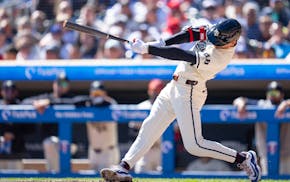The Vikings will sell the idea that the loss of Jake Long to an Achilles injury was another bad break for the offensive line. Certainly, it was that for Long as an individual, but for the team it was an example of what should have been expected as the Vikings took the easy way out in trying to fix the offensive line.
Injuries caused Long to miss more than half of the 2014 season with the St. Louis Rams. He barely played for the Atlanta Falcons in 2015 for the same reason, and he was without a job until the Vikings signed him on Oct. 11.
That desperation had arrived after starting right tackle Andre Smith went on injured reserve with a broken arm. The left tackle, Matt Kalil, had been lost to injury in September.
Those were bad breaks. Another injury of some form for Long was predictable. Once a behemoth breaks down, as had Long, the chance of regaining durability in his 30s is remote.
The Vikings had defeated Houston on Oct. 9, with T.J. Clemmings playing at left tackle and Jeremiah Sirles at right tackle. That put the Vikings at 5-0, and they were being talked up as the NFC favorites to reach the Super Bowl.
There was a bye week and then the Vikings were overrun by Philadelphia (somewhat understandable) and by Chicago (not at all understandable). The trade deadline was two days later and the Vikings had two choices:
Make a dramatic move to reinforce the tackle position and maintain an elite status in the NFC, or roll with as Long as the left tackle and pray for durability.
They chose prayer.
They were hard up against the salary cap and it would have taken magic from Rob Brzezinski to find room for either of two durable, top-caliber tackles: Joe Thomas in Cleveland and Joe Staley in San Francisco.
Of course, Brzezinski is known as a salary-cap Houdini. He might have found room with reworked contracts for the cap hit of close to $5 million for Thomas or around $3.5 million for Staley for the remainder of this season.
Thomas turns 32 next month, Staley is 32, and both would have taken care of the left tackle vacancy that will exist next season, with Kalil likely to move on as a free agent. Kalil also would be taking an $11 million salary with him, so the money due to Thomas or Staley was not an issue for 2017.
Maybe it was too much for Brzezinski to find the cap room by reworking deals. Maybe bringing in quarterback Sam Bradford with his large salary was all the magic he had in him for this season of great possibility.
Maybe a minimal deal for Long was it; that the Vikings' only option was to take Long as a long-shot attempt at a fix, and then suffer with it in the likelihood that he didn't make it to the finish line.
Brzezinski did have three weeks to do his math -- from when it became apparent that Smith would be lost until the Nov. 1 deadline. And the Vikings were aware of the guaranteed problem solvers who were out there: Thomas and Staley.
Cleveland was alleged to be willing to take a second-rounder for Thomas. Chip Kelly was alleged to want a first-rounder for Staley, although that was probably bluster.
I'm not buying that Brzezinski had been thrown a math problem that he couldn't solve in three weeks.
It was General Manager Rick Spielman's paranoia over future drafts that prevented the Vikings from taking a plunge that would have allowed them to remain strong contenders for a Super Bowl return after 40 years.
Bradford already had cost the first and fourth picks in the 2017 draft. Cleveland or San Francisco might have been convinced to wait until 2018 to collect a bounty for their left tackles.
The Vikings passed, and they have lost two more games in November, and now they have Alex Boone volunteering to play left tackle.
This predicament is as much their choice as bad luck.

Live: Minnesota United at Charlotte FC. Follow on Gameview.
Jameson Taillon comes off the injured list and helps the Cubs beat the Marlins 8-3
T-wolves take NBA's best defense into series vs. Suns, but can it stop Durant-Booker-Beal trio?

